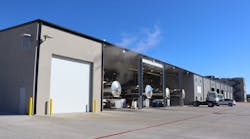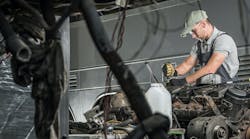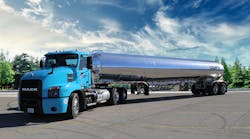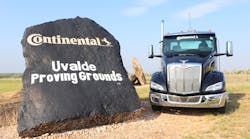MARK Bauckman believes the word “telematics” means a lot of different things to a lot of different people.
“We all have a different perspective based on our roles in our organizations,” said Bauckman, director of sales and strategic accounts for Omnitracs LLC. “To me, there’s a system integrations side in terms of what’s going on inside to improve the driver’s quality of life and user experience. Space is at a premium, so it’s about trying to optimize some of the simple user interface areas.
“There’s a lot of activity with data integration and the amount of data these systems are generating. But what do you do with it? How do you make it actionable and predictive?”
Bauckman moderated a panel, “Tractors and Telematics: Improving Onboard Technology Integration” during the 2014 Tank Truck Week in Houston, Texas. Panelists included: Dave Bryant, vocational account manager for Houston Freightliner; Conal Deedy, director of connected vehicle services for Volvo Trucks; and Thomas Platts, fleet sales director for Kenworth.
Q: Start with the in-cab tractor side as it relates to telematics, technology, and systems integration. What are you hearing from fleets and drivers as it relates to the desire to increase productivity, improve safety and the user experience within the cab of the vehicle?
Bryant: “With the onset of EPA10 technology, these engines are far more complex. If the driver sees the “check engine” light—and he will see it more now than he ever does because of onboard diagnostic requirements and government mandates to provide notification of a potentially out-of-compliance condition—fleets are saying, “What do we do? How can we keep the truck running?”
“Daimler products recognized that our EPA10 engine development was going to be a critical issue. We developed a virtual technician package to help fleets and drivers know what to do. With the virtual technician, the truck itself will send information to the call center in Detroit. Within two minutes, that fleet manager is going to get an email notification: “you can ignore this,” “you can deal with this the next PM,” or “you need to take that truck down; here are the dealers closest to your location that have the part most likely to be replaced.” So uptime has been one of the most critical things.
“The second key area we see still is a real drive for fuel economy and driver safety. Safe driving habits are also very conducive to fuel-economy performance. So fleets are looking for tools that help give driver feedback on better safe driving, fewer hard brake events, and better driver habits. Fleets are looking for technology-neutral capability in the truck. They want one tool or technology.”
Deedy: “Uptime, uptime, uptime. Customers are telling us they want support from the OEM, and that’s what we’re delivering. We continue to refine our package to make sure we’re giving good information to our customers and drivers. That’s where telematics helps. We now send that information to the decision-maker with a profile they can customize. That is the communication that adds value and helps the driver.
“There are a number of devices going into the cab. I’ve gone into truck stops and seen outlets full of charges. They have five or six different devices, and sometimes they have four different subscriptions—each one is sending data to a different system. It’s overload, and it will be unnecessary in the future as we try to embed this technology into the truck at the factory. That’s what we’re starting to do at Volvo. Make it simple and easy. When the customer receives the truck, it’s coming factory-fit. They can just turn the key and go. And then with the systems they use, they only have to log into one place, or data gets pushed to them on alerts that they don’t have to go in and monitor. They want actual information in real time.”
Platts: “Years ago, it was the truck driver who called and said, ‘The truck’s broke.” Now the truck can do it itself. You want to start thinking in terms of what is causing that prompt and what do you do about that prompt? That’s where the next level of telematics will be brought forth. They want to improve that downtime. The other thing is, you could need three or four different cell devices transmitting data. You need to start thinking of what information you do need that’s available on the truck that would be appropriate for this kind of communication device.”
Bauckman: “There’s no one single solution that’s right. There’s a certain set of core capabilities and certainly as we’re going forward, there’s the electronic log mandate from a compliance perspective, but vocations differ, operations differ. And I think systems going forward need to be flexible enough to accommodate different needs. We’re seeing more and more the desire to do more outside the cabin, whether it’s vehicle inspection reporting, customer service signature or image capture bar code scanning. Younger drivers in particular are bringing devices inside the cab. Customers certainly want to see lower-cost systems, so to the extent you can leverage off-shelf hardware to support what’s going on inside the vehicle, that’s a good thing. There is no one right solution. Flexibility is important. Now there is a concern about overwhelming the driver with information. What do you want the driver to do first and foremost? Operating the vehicle safely and serving the customer. You have to take a hard look at everything else going on inside the cab and take a look at whether it’s running contrary to those driving objectives.”
Q: Anything else in terms of general truck design? You have a fixed amount of space inside the cab. Any big steps forward?
Deedy: “Volvo has already launched an embedded telematics device that is hard to see and get to. It’s connected to three different data buses. It allows that device to capture information all over the truck. We pair that through partnering with a mobile device. A mobile device lasts two or three years and a truck lasts 15 years. Embedded hardware is designed to deliver in that environment but it’s a lot easier to update a mobile app than to re-roll hardware. Over 82% of drivers are bringing in smartphones. We can take advantage of that as an interface and build a nice bracket. That’s the way we’re going. It allows the flexibility. It’s very important that we give customers flexibility. It’s information they want that you need to be able to provide.”
Platts: “Think about all the systems you guys operate on a daily basis: accounting, human resources, dispatch, billing—all those things related to what’s happening in the truck. We have to develop sources for you to be able to transmit that data. That lends itself more to what I’m suggesting—that you have to think about all systems integrated and how you can improve your operations.”
Q: Let’s shift focus to the back-office side. What are you hearing as it relates to the data and how people are using it today? The challenges today are more and more data and people having difficulty sorting through it. Actionable data and exception-based data.
Platts: “The biggest thing I hear is the term “predictive maintenance.” When you look at data that’s captured on the ECM (electronic control module) that can be transmitted, we start to get a little quicker in fixing problems. Today as an OEM, we’ve got working results and we track that, but that’s late information and often information communicated through several hands. If you think about eliminating that and having instantaneous data come to us that tells us about a problem, it makes us more responsive to the point that maybe we can get into predicting when parts will fail and replacing them before they fail.”
Deedy: “That’s a real benefit to the industry. These trucks are getting very complicated. There are a lot of revisions of engines that require a lot of programming and software done. Now having that connectivity to results that are coming out in almost real time helps us make better engines and gives information to customers about what’s going wrong. That’s very helpful to the industry to drive it forward. Also, we are working on these partnering services, so Volvo is very concerned. We want to be the leader in uptime. That’s our focus. That’s what we’re good at.
“Information we also get off the truck we can share with others. If a customer wants to subscribe to those services, that’s where we’re going. So we can have the best of both worlds.
Bryant: “One of the things Detroit has done: Because they’ve been collecting this data for several years, they’ve been able to bucket different fault codes into informational messages. ♦
2014 Tank Truck Week coverage on various cargo tank issues
2014 Tank Truck Week coverage on ELDs
Find the NTTC Tank Truck Week archive with articles from 2014 to present










